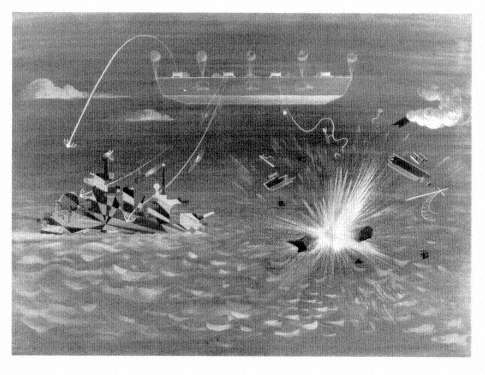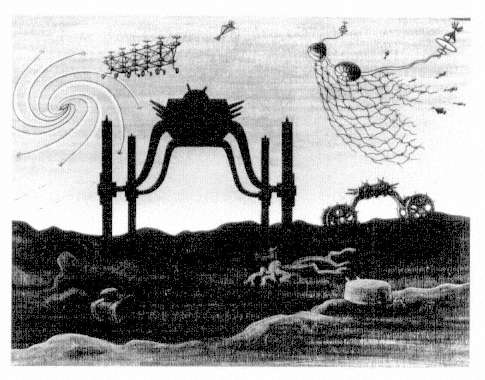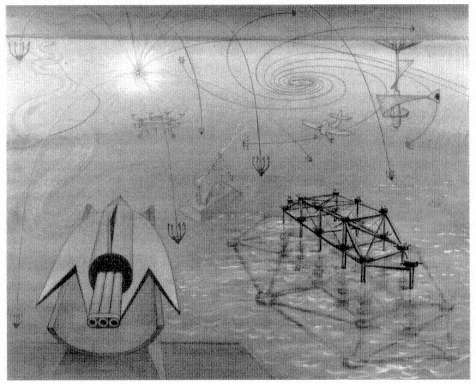Clay Spohn's Fantastic War Machines
In the summer of 1941, some six months before the bombing of Pearl Harbor, the San Francisco artist Clay Spohn began having recurring dreams about battling the Axis powers with fantastic weapons of war. "They were not nightmares," he recalled, "but like great spectacles of color."[23] Spohn took profuse notes on these dreams, waking in the middle of the night to make elaborate annotated "obsession drawings." Most of his more than two hundred ideas for war-related paintings never evolved beyond scrap paper, but at the urging of his good friend Charles Howard, Spohn produced enough finished works for an exhibition. A notorious procrastinator, Spohn worked on them until the very eve of their presentation. On February 22, 1942, two months after America entered the Second World War, Spohn's Fantastic War Machines and Guerragraphs premiered at the San Francisco Museum of Art.
The critical reaction to Spohn's exhibition was alternately baffled and bemused. It was difficult to say whether the artist was ridiculing the war effort or merely indulging in escapist fantasy. The show consisted of nine meticulously drawn, elaborately captioned gouache renderings of weaponry, which, as one critic quipped, illustrated some very unorthodox ways of winning the war.[24]Hover Machine (Fig. 17), for example, showed a device that could snare enemy vessels from both sea and air at lightning speed with the grappling hooks it ejected on cables from lubricated windlasses. Tornado Machine depicted an electronically controlled cyclone; Spy Detector showed an ornately decorated vehicle with outsize spy glasses; Balloonic Uplifters represented brassiere-shaped nets to entrap enemy aircraft; and the mammoth Rolling Fort (Fig. 18) featured

Figure 17
Clay Spohn, Hover Machine , 1942. Gouache on paper, 15 × 20 in. The Oakland
Museum, gift of the Estate of Peggy, Nelson Dixon. Photograph by M. Lee Fatherree.

Figure 18
Clay Spohn, The Rolling Fort , 1942. Watercolor on matboard, 18¾ × 26 1/8 in.
Nora Eccles Harrison Museum of Art, Utah State University, Logan, Utah.
Gift of the Marie Eccles Caine Foundation.
a chassis one hundred and twenty feet above the ground. Spohn's exhibition also included eleven drawings and gouaches of various war-related subjects, for which Douglas MacAgy, the show's curator, coined the term Guerragraph , from the Spanish word for war. At least one of the Guerragraphs anticipated the "Spy vs. Spy" cartoons of Mad Magazine , showing spies engaged in various ludicrous operations, such as peering at each other from around the corners of buildings and from other conspicuous hiding places.[25]
Spohn's War Machines and Guerragraphs have often been classified as surrealist, and indeed, Spohn borrowed liberally from that movement.[26] Stylistically, his approach was closest to that of René Magritte, Dalí, and Tanguy, who sought to fix dream-inspired images by illusionistic means. Spohn's work resembles that of these artists in its crisp delineation and smooth, unmodulated colors as well as in the artist's tendency, particularly in the Guerragraphs , to suspend forms weightlessly in a dreamlike landscape (Fig. 19). But Spohn's variety of madcap comedy is unusual in surrealism. His playful antics seem blissfully naive compared with the black humor of Magritte or Dalí. When the Europeans dealt explicitly with the subject of war, there was little lighthearted humor. Magritte's Black Flag (1937), for example, makes a striking contrast with Spohn's renditions. Magritte's war machines are equally fantastic and irrational, but their dark silhouettes are ominous and funereal. Hovering above a colorless landscape depleted of life, they could be, as Sidra Stich has suggested, the futuristic relics of a dead civilization.[27] Spohn was less concerned with the sinister implications of war, in large part because he did not subscribe to surrealism's Freudian view of humanity as inherently barbaric. Spohn preferred to focus on the positive elements of human nature, and he did not share the surrealist ambition to discommode the social status quo by revealing the dark and unruly workings of the mind. If, like the surrealists, Spohn hoped to short-circuit the intellect through humor and fantasy, it was rather to intensify the pleasure of life.[28]
In this sense, Spohn's approach was closer to Alexander Calder's than to that of any of the surrealists. Calder's whimsical mechanical sculptures may in fact have been an important stimulus for Spohn, since the two artists had known each other since their days at the Art Students League in New York and had worked in adjacent studios in Paris during the 1920s. It was apparently Spohn whose suggestion that Calder work with wire ultimately led him to invent the mobile.[29] Spohn's colorful kites and streamers and his kinetic Wind Machine for San Francisco's Open Air Show in 1941 were very much in the spirit of Calder's fanciful mobiles and circus toys.
Yet Spohn's War Machines were perhaps closer still to the preposterous contraptions of Rube Goldberg, then a popular cartoonist for the New York Evening Sun . Goldberg's mural Automatic Hitler Kicking Machine (1942) was as filled with impossible gadgetry as Spohn's inventions.[30] It would hardly be surprising if Spohn had admired Goldberg. since Spohn had also begun as a cartoonist.[31] Although he quickly abandoned cartoon work to pursue a career in painting, he continued to amuse himself and others with his

Figure 19
Clay Spohn, The Unsinkable Fort , 1942. Gouache, pencil, and crayon on paper,
17 ¾ × 21 in. Collection of John E Axelrod, Boston. Photograph by Michael Korol.
considerable comedic talent. Spohn was acclaimed in San Francisco in the 1940s particularly for his zany assemblages—the best known being his Museum of Unknown and Little-Known Objects (1949), which featured such whimsical exhibits as Bedroom Fluff , a collection of dust balls Spohn gathered from under a friend's bed; Old Embryo, a rubber Halloween mask floating eerily in a chemist's flask; and Mouse Seeds , a jar of mildewed rice. Spohn described these creations as "prankisms," acknowledging that they lacked the intellectual underpinnings of dada or surrealism.[32] Like many American modernists, Spohn approached art instinctually rather than theoretically.[33] Indeed, he was attracted to humor precisely because it afforded "a kind of free release from the bondage of dogma."[34]
The moment when Spohn's Fantastic War Machines debuted at the San Francisco Museum of Art could hardly have been more tense. In early 1942 the Japanese were rapidly overpowering the small, ill-equipped American garrisons on Pacific islands. The
fall of Bataan in the first few months of 1942 was probably the nadir of the war for the Allies, coming shortly after the loss of Singapore and Hong Kong and the sinking of the great British battleships the Prince of Wales and the Repulse .[35] Although most San Franciscans experienced these events only in news reports, the war was difficult to forget with such daily reminders as the convoys of warships filing steadily through the Golden Gate, with Angel Island overflowing with German and Japanese prisoners of war, and with such strange sights as the enormous Kaiser Shipyards, so busy producing Liberty ships that, as Dos Passos reported, they glowed all night long like forest fires.[36] Not only was San Francisco the major supply port for troops and munitions fueling the war effort, but it was also America's lifeline. The daily plasma drives and Red Cross blood banks springing up in such places as the California School of Fine Arts on Russian Hill were a grisly reminder that a massive war was on.
The anxiety was particularly acute in the months just after the bombing of Pearl Harbor. As the most strategically important port in the country, and hence America's front line, San Francisco was consumed by fear of becoming the next target. Blackouts were nightly events, and posters around the city warned civilians and soldiers alike to "zip your lip" since "loose lips sink ships." The paranoia can be measured by the rumors that filled the local newspapers. One story accused Japanese-born farmers of planting their tomatoes in the shape of an arrow to guide enemy bombers.[37] Another claimed that the Italian residents of North Beach were protecting their homes from air attack by painting swastikas on their roofs.[38]
Spohn's humorous spies and fantastic weaponry thus clearly ministered to a desperate need to relieve the tension.[39] Yet while Spohn certainly intended that the War Machines and Guerragraphs amuse, he also meant them as provocative satire. As Spohn's biographer, David Beasley, has written, these paintings "mocked imaginatively their original unworkableness as much as they mocked the seriousness of war."[40] They suggested the fiction of the government's and the media's grandiose claims that American weapons were invincible. The critic who described Spohn's War Machines as "Popular Science gone nuts"[41] had clearly not picked up a recent issue of the magazine, or he would have known that Spohn's ideas were not so distant from some of the armament designs seriously proposed at the start of the war, such as John Hodgdon's "Gyroscope Torpedo" and George Walker's flying "Mosquito Boat."[42] Spohn's War Machines , for which he concocted elaborate deadpan captions, deftly parodied such hopeful inventions. But it was not necessary to look at magazines specializing in science and industry; publications like Time and Newsweek were filled with praise for the ingenuity of American war technology, with the sort of bravado voiced in an advertisement for Corsair bombers that appeared in the December 1942 issue of the Saturday Evening Post : "Woe to any Jap or Nazi that tries to slip away! This new Navy fighter has 'got the drop' on everything under the axis sun!"[43]
As a veteran of the First World War, Spohn was somewhat skeptical of Allied slogans about swift victory. His assemblage Wake Up and Live , constructed around the same
time as the War Machines , expressed his concern that, as he later explained, "if we didn't wake up to the real facts that were going on with the war in Europe and so on, we might find ourselves in a bad way."[44] Wake Up and Live , consisting of a painted fly in a shadow box that could be swatted by pulling a chain, offered a graphic image of what could happen if America merely remained "a fly on the wall" during the conflict. By ridiculing America's claims to military prowess, the War Machines and Guerragraphs conveyed a similar warning about the need for preparedness. Spohn could scarcely have known how close to the truth he was. Only the military elite and those who did the actual fighting knew the deadly inefficiency of such highly touted war machines as the B-17 Flying Fortresses.[45] As Paul Fussell observed, few could have predicted that "before the war ended the burnt and twisted bits of almost 22,000 of these Allied bombers would strew the fields of Europe and Asia, attended by the pieces of almost 110,000 airmen."[46]